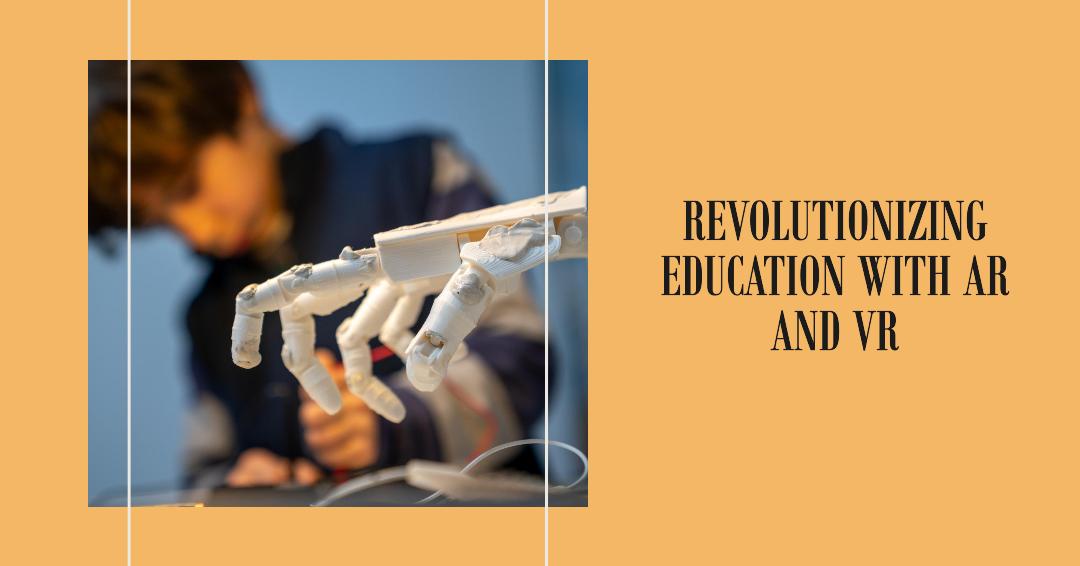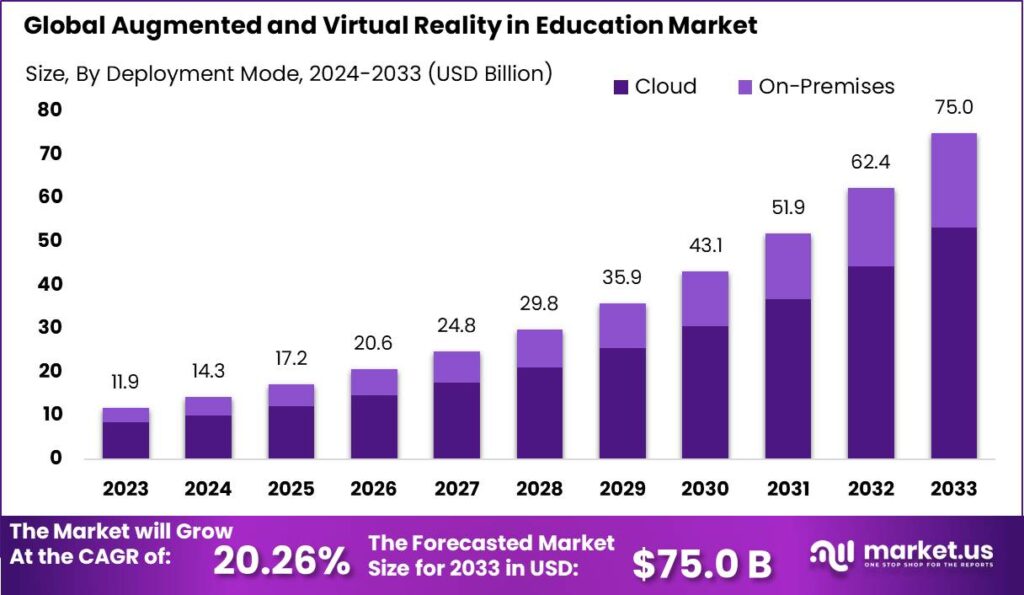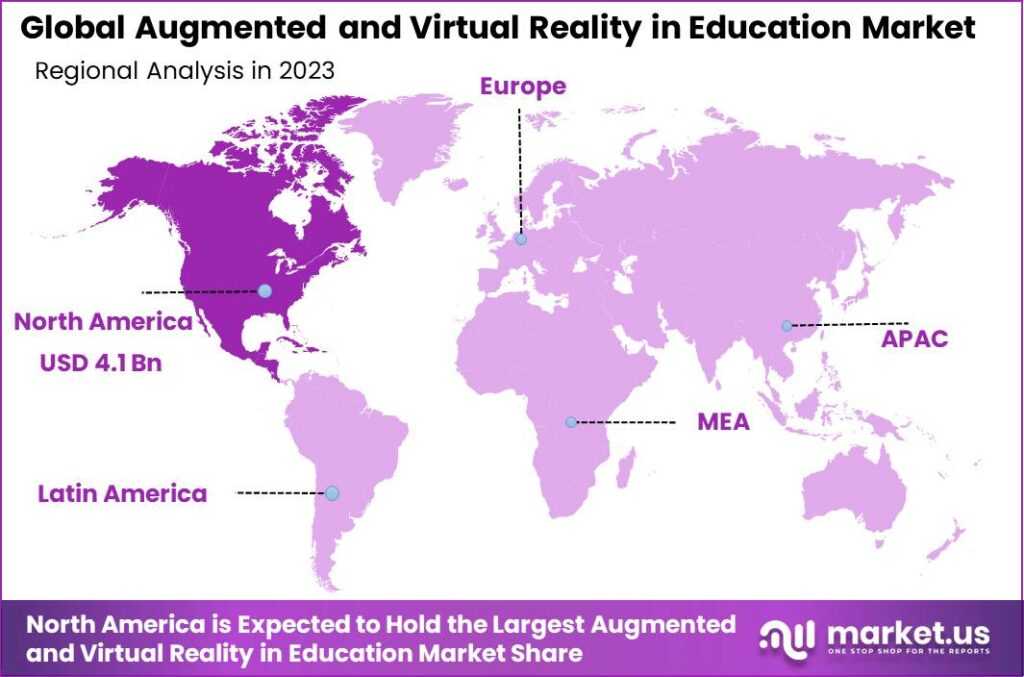Augmented and Virtual Reality in Education Market Demand to Hit USD 75 Billion by 2033

Page Contents
The Augmented and Virtual Reality in Education Market is poised for remarkable growth, with estimations suggesting its value could reach USD 75 billion by 2033, showcasing a robust Compound Annual Growth Rate (CAGR) of 20.26% from 2024 to 2033.
The integration of Augmented Reality (AR) and Virtual Reality (VR) technologies into the education sector marks a significant evolution in pedagogical approaches, offering immersive and interactive learning experiences that transcend traditional classroom boundaries. These technologies facilitate a rich, multi-sensory learning environment, allowing for complex concepts to be visualized and understood in a more engaging and effective manner.
The market for AR and VR in education is characterized by its rapid growth, driven by the increasing demand for innovative and effective teaching methods. This growth is further bolstered by advancements in AR and VR technologies, making them more accessible and affordable for educational institutions. The market encompasses a wide range of applications, from K-12 and higher education to vocational training, encompassing subjects as diverse as science, history, and language arts.
Don't miss out on business opportunities | Get sample pages @ https://market.us/report/augmented-and-virtual-reality-in-education-market/request-sample/

Research Findings
- Market Growth Projection: The global augmented and virtual reality in education market is projected to reach an impressive value of USD 75 billion by 2033, indicating a robust compound annual growth rate (CAGR) of 20.26% from 2024 to 2033.
- Growth in Implementation: The adoption of AR and VR technologies in K-12 schools is expected to witness substantial growth, with over 40% of schools projected to incorporate these technologies by 2024, a significant increase from less than 20% in 2022. Additionally, a survey found that 93% of teachers believe VR would be beneficial in classroom teaching, indicating strong support for immersive technologies in education.
- Revenue Generation: Revenue from education-focused VR software is forecasted to exceed $300 million globally by 2024, highlighting the increasing demand for tailored VR solutions in education. European VR education startups are also poised to experience a 30% increase in funding in 2023 and 2024, signaling sustained confidence in the potential of VR in education.
- Higher Education Sector Leadership: The higher education segment emerges as a dominant player, with over 60% of US colleges expected to offer at least one VR-based course by 2024, compared to less than 30% in 2022. This underscores the growing recognition of VR's value in higher education for immersive and interactive learning experiences.
- Hardware and Cloud Dominance: In 2023, hardware, particularly interactive whiteboards, portable controllers, and VR devices, held a dominant market position, capturing over 65% of the market share. Cloud-based deployment also dominated, with more than a 71% share, owing to its scalability, flexibility, and cost-effectiveness in deploying AR/VR applications.
- Regional Analysis: North America leads the augmented and virtual reality in education sector, commanding over 35% market share in 2023. Factors such as robust technological infrastructure, substantial investments, and proactive adoption by educational institutions contribute to its leadership position.
Top Trends Shaping the AR/VR in Education Market
The Augmented Reality (AR) and Virtual Reality (VR) in education market is undergoing rapid transformation, driven by several key trends that are shaping its future direction. These trends not only reflect the evolving technological landscape but also the changing needs of learners and educators alike. Here are the top trends currently shaping the AR/VR in education market:
- Immersive Learning Experiences: AR and VR technologies are increasingly being used to create immersive learning environments that engage students in a hands-on manner. This trend is fueled by the recognition that immersive experiences can enhance understanding and retention of complex subjects by simulating real-world scenarios.
- Gamification of Education: The integration of game elements into educational content through AR and VR is becoming more prevalent. This approach leverages the motivational aspects of games to make learning more engaging and fun, thereby improving student participation and outcomes.
- Personalized Learning: AR and VR technologies are enabling more personalized learning experiences by adapting to the individual needs, skills, and learning pace of each student. This trend is facilitated by the ability of these technologies to provide immediate feedback and adjust difficulty levels in real-time.
- Collaborative Learning Environments: There is a growing emphasis on using AR and VR to support collaborative learning experiences, where students can work together in virtual spaces regardless of their physical location. This trend underscores the importance of social interaction in learning and the potential of AR and VR to foster community and teamwork.
- Accessibility and Inclusivity: Efforts are being made to ensure that AR and VR educational tools are accessible to all learners, including those with disabilities. This trend towards inclusivity involves the development of content and interfaces that are adaptable to various needs, ensuring equitable access to educational opportunities.
- Integration with Other Technologies: AR and VR are increasingly being integrated with other emerging technologies such as Artificial Intelligence (AI) and the Internet of Things (IoT) to create more intelligent and interactive learning environments. This trend reflects the convergence of technologies in shaping the future of education.
Buy Now this Premium Report to Grow your Business: https://market.us/purchase-report/?report_id=115806
Top Market Leaders
- Meta
- Microsoft Corporation
- Magic Leap, Inc.
- Sony Group Corporation
- Panasonic Holdings Corporation
- HTC Corporation
- Vuzix Corporation
- Lenovo
- Anthology Inc.
- Avantis Systems Ltd
- DAQRI LLC
- Samsung Electronics Co. Ltd
- Other Key Players
Recent Developments
HTC Corporation
- January 2023: Introduced the VIVE XR Elite, a cutting-edge headset that merges VR and MR technologies, offering educational institutions a versatile tool for a variety of applications.
- June 2023: Formed a collaboration with HTC Vive Sync to innovate VR classroom experiences, enabling interactive and collaborative learning spaces for educators and students in virtual settings.
Vuzix Corporation
- March 2023: Launched the Vuzix M400 smart glasses, featuring enhancements in comfort and display quality, making it an attractive option for educational settings interested in AR.
- October 2023: Entered a partnership with VictoryXR to create an AR app for anatomy visualization, providing an engaging and interactive method for students to learn about human anatomy.
Lenovo
- February 2023: Released the “Lenovo VR Classroom 2” solution, a comprehensive package of hardware and software tailored for immersive VR learning experiences.
- September 2023: Teamed up with Labster VR to integrate VR science simulations into Lenovo's VR Classroom solution, thereby broadening the range of educational content available.
Regional Analysis
In 2023, North America was the leading region in the augmented and virtual reality (AR/VR) market for education, holding over a 35% share of the global market. The value of AR/VR in the education sector in North America was estimated at $4.1 billion for that year. Looking ahead, it's expected that this market will see substantial growth. This trend suggests that AR/VR technologies are becoming increasingly important tools for educational purposes in North America, indicating a strong potential for further expansion and development in this sector.
This market can be attributed to several key factors. Firstly, the region has a strong technological infrastructure, which provides a solid foundation for the adoption and integration of advanced technologies like AR/VR in educational settings. Additionally, there is a high level of investment in research and development from both the public and private sectors, driving innovation and the development of new AR/VR educational applications.
The presence of major technology companies, many of which are pioneers in AR/VR technologies, also contributes significantly to the region's dominance. Furthermore, there is a growing recognition among educational institutions in North America of the potential of AR/VR to enhance learning and teaching processes. This has led to an increased willingness to adopt these technologies in classrooms and educational programs. Together, these factors ensure North America's leading role in leveraging AR/VR technologies for educational purposes, indicating a robust and evolving market.

Driver
One major driver of the augmented and virtual reality (AR/VR) market in education is the increasing demand for interactive and immersive learning experiences. AR/VR technologies offer innovative ways to engage students, making learning more appealing and effective. These technologies enable learners to explore complex subjects through virtual simulations, enhancing understanding and retention of knowledge.
Restraint
A significant restraint facing the AR/VR in education market is the high cost of implementation. The initial expenses for AR/VR hardware and software, along with the need for ongoing maintenance and content development, can be prohibitive for many educational institutions. This financial barrier can slow down the adoption rate of AR/VR technologies, particularly in regions with limited educational budgets.
Opportunity
The ongoing development of more affordable AR/VR technologies presents a substantial opportunity for the education sector. As the costs of VR headsets and AR applications decrease, these technologies become more accessible to a wider range of educational institutions. This democratization of AR/VR technology could lead to its widespread adoption in classrooms around the world, revolutionizing the way educational content is delivered and experienced.
Challenge
One of the major challenges in integrating AR/VR into education is the lack of technical skills among educators. For AR/VR programs to be effectively implemented and utilized, teachers need to be adequately trained to operate these technologies and integrate them into their curriculums. Overcoming this challenge requires significant investment in professional development and support for educators, ensuring they are equipped to leverage AR/VR tools to enhance learning outcomes.
Conclusion
In conclusion, the augmented and virtual reality (AR/VR) market in education is at a pivotal stage, marked by significant growth potential and evolving technological landscapes. North America's leadership in this sector underscores the region's robust technological infrastructure, innovation-driven culture, and proactive adoption of AR/VR in educational settings. While the high cost of implementation and the need for technical skills among educators present notable challenges, these are counterbalanced by the driving force of an increasing demand for interactive learning experiences and the opportunity presented by more affordable AR/VR solutions. As the sector navigates these dynamics, the future of AR/VR in education appears promising, poised for further expansion and deeper integration into learning environments worldwide.
Contact us
Contact Person: Mr. Lawrence John
Market.us (Powered By Prudour Pvt. Ltd.)
Tel: +1 718 618 4351
Send Email: [email protected]
The team behind market.us, marketresearch.biz, market.biz and more. Our purpose is to keep our customers ahead of the game with regard to the markets. They may fluctuate up or down, but we will help you to stay ahead of the curve in these market fluctuations. Our consistent growth and ability to deliver in-depth analyses and market insight has engaged genuine market players. They have faith in us to offer the data and information they require to make balanced and decisive marketing decisions.